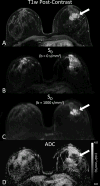DWI in the Assessment of Breast Lesions
- PMID: 28961569
- PMCID: PMC5662124
- DOI: 10.1097/RMR.0000000000000137
DWI in the Assessment of Breast Lesions
Abstract
Diffusion-weighted imaging (DWI) holds promise to address some of the shortcomings of routine clinical breast magnetic resonance imaging (MRI) and to expand the capabilities of imaging in breast cancer management. DWI reflects tissue microstructure, and provides unique information to aid in characterization of breast lesions. Potential benefits under investigation include improving diagnostic accuracy and guiding treatment decisions. As a result, DWI is increasingly being incorporated into breast MRI protocols and multicenter trials are underway to validate single-institution findings and to establish clinical guidelines. Advancements in DWI acquisition and modeling approaches are helping to improve image quality and extract additional biologic information from breast DWI scans, which may extend diagnostic and prognostic value.
Figures








Similar articles
-
Diffusion-weighted breast MRI: Clinical applications and emerging techniques.J Magn Reson Imaging. 2017 Feb;45(2):337-355. doi: 10.1002/jmri.25479. Epub 2016 Sep 30. J Magn Reson Imaging. 2017. PMID: 27690173 Free PMC article. Review.
-
Diffusion-Weighted Imaging With Apparent Diffusion Coefficient Mapping for Breast Cancer Detection as a Stand-Alone Parameter: Comparison With Dynamic Contrast-Enhanced and Multiparametric Magnetic Resonance Imaging.Invest Radiol. 2018 Oct;53(10):587-595. doi: 10.1097/RLI.0000000000000465. Invest Radiol. 2018. PMID: 29620604 Free PMC article.
-
Intravoxel incoherent motion diffusion-weighted imaging as an adjunct to dynamic contrast-enhanced MRI to improve accuracy of the differential diagnosis of benign and malignant breast lesions.Magn Reson Imaging. 2017 Feb;36:175-179. doi: 10.1016/j.mri.2016.10.005. Epub 2016 Oct 11. Magn Reson Imaging. 2017. PMID: 27742437
-
Diffusion-weighted MRI of breast lesions: a prospective clinical investigation of the quantitative imaging biomarker characteristics of reproducibility, repeatability, and diagnostic accuracy.NMR Biomed. 2016 Oct;29(10):1445-53. doi: 10.1002/nbm.3596. Epub 2016 Aug 24. NMR Biomed. 2016. PMID: 27553252
-
Update on DWI for Breast Cancer Diagnosis and Treatment Monitoring.AJR Am J Roentgenol. 2024 Jan;222(1):e2329933. doi: 10.2214/AJR.23.29933. Epub 2023 Oct 18. AJR Am J Roentgenol. 2024. PMID: 37850579 Free PMC article. Review.
Cited by
-
Multinuclear MRI to disentangle intracellular sodium concentration and extracellular volume fraction in breast cancer.Sci Rep. 2021 Mar 4;11(1):5156. doi: 10.1038/s41598-021-84616-9. Sci Rep. 2021. PMID: 33664340 Free PMC article.
-
Feasibility study of 2D Dixon-Magnetic Resonance Fingerprinting (MRF) of breast cancer.Eur J Radiol Open. 2022 Nov 16;9:100453. doi: 10.1016/j.ejro.2022.100453. eCollection 2022. Eur J Radiol Open. 2022. PMID: 36411785 Free PMC article.
-
Diffusion processes modeling in magnetic resonance imaging.Insights Imaging. 2020 Apr 28;11(1):60. doi: 10.1186/s13244-020-00863-w. Insights Imaging. 2020. PMID: 32346809 Free PMC article.
-
Imaging Microstructural Parameters of Breast Tumor in Patient Using Time-Dependent Diffusion: A Feasibility Study.Diagnostics (Basel). 2025 Mar 24;15(7):823. doi: 10.3390/diagnostics15070823. Diagnostics (Basel). 2025. PMID: 40218173 Free PMC article.
-
Characterizing Breast Tumor Heterogeneity Through IVIM-DWI Parameters and Signal Decay Analysis.Diagnostics (Basel). 2025 Jun 12;15(12):1499. doi: 10.3390/diagnostics15121499. Diagnostics (Basel). 2025. PMID: 40564820 Free PMC article.
References
-
- DeMartini W, Lehman C, Partridge S. Breast MRI for cancer detection and characterization: a review of evidence-based clinical applications. Acad Radiol. 2008;15(4):408–416. - PubMed
-
- American College of Radiology. Breast Magnetic Resonance Imaging (MRI) Accreditation Program Requirements. http://www.acraccreditation.org/~/media/ACRAccreditation/Documents/Breas.... - PMC - PubMed
-
- Morris EACC, Lee CH, et al. ACR Breast Imaging Reporting and Data System. 5th. Reston, VA: American College of Radiology; 2013. ACR BI-RADS Magnetic Resonance Imaging.
-
- Guo Y, Cai YQ, Cai ZL, et al. Differentiation of clinically benign and malignant breast lesions using diffusion-weighted imaging. J Magn Reson Imaging. 2002;16(2):172–178. - PubMed
MeSH terms
Substances
Grants and funding
LinkOut - more resources
Full Text Sources
Other Literature Sources
Medical
Research Materials

